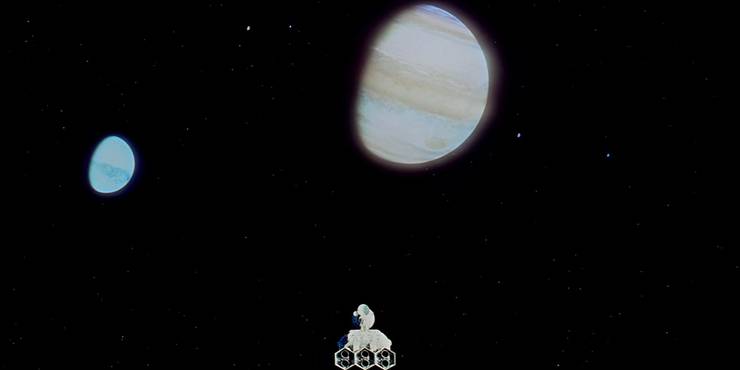10 Things 2001: A Space Odyssey Got Wrong About The Future

Way back in 1968, Stanley Kubrick changed the face of sci-fi moviemaking (permanently) with his masterclass project 2001: A Space Odyssey. For the first time, a space-themed movie went beyond flying saucers, ray guns and mutant monsters in rubber suits, and ascended to a higher plateau of storytelling and technical authenticity.
Along the way, 2001: A Space Odyssey made some bold predictions about what life would be like 33 years later. Many of them turned out to be true, especially when it comes to technology, while other predictions weren’t as accurate. Some hit the mark but missed the date, while others still have a long way to go before they move past the practical and/or theoretical stages.
10 Long-Distance Space Exploration

2001 depicts the Discovery One traveling to Jupiter with doctors David Bowman and Frank Poole on board. There, they discover a huge monolith tied to the first two glimpsed previously in the film. It’s a breathtaking scene that feels authentic and real, solidifying the film as one of the best deep space dramas ever made.
Humans have a long, long way to go before they’re venturing out that far. Part of the reason involves the physics of space, itself. While satellites have managed to trek to Jupiter in as little as 550 days, a spacefaring crew hoping to establish orbit around the planet would need to travel much slower, lest they soar right by. Current estimates place such a trip at around six years, which is difficult to fathom right now.
9 Artificial Gravity

It might seem quirky and cool to float about in zero gravity, but that spells doom for anything resembling long-term space exploration. In the end, humans will have to figure out a way to duplicate the force of gravity in order to make a go of it. There are several methods of achieving artificial gravity, and 2001 utilizes one of the most effective.
Newton’s third law plays a big role here, specifically as it relates to centrifugal force. This might be the first method humans perfect in order to simulate gravity, though it probably won’t be the last. NASA has successfully tested the technology, but it’s never been utilized in space at this point. The crippling factor, right now, is the cost.
8 Artificial Intelligence

Of all the future predictions depicted in 2001, artificial intelligence is the one it managed to predict so well, yet get so wrong at the same time. The homicidal computer known as HAL 9000 suffers a nervous breakdown due to an impasse of logic in one of Stanley Kubrick’s most pivotal and memorable scenes.
Today’s artificial intelligence is making strides, but it’s mostly limited to machine learning and predictive responses, rather than full-fledged interaction and conversation. AI projects like IBM’s popular Watson are looking more and more like HAL 9000 all the time, but there’s little going on there besides beating human contestants on Jeopardy!
7 Computer Hardware

Much of the computerized hardware in 2001 bears similarities to the type of technology used today, but there’s no way anyone could have predicted just how far real-world computing would leapfrog year over year. While the premise is the same, there’s something antiquated about the way computer technology is depicted in the film.
Though the use of tablets seems to be spot on, those items weren’t a thing until around 2010. Other types of computer hardware lack the sleek and streamlined interfaces humans have come to regard as commonplace. Even mice and keyboards were relatively newfangled technologies when 2001 was made, and as such, didn’t feature in the film’s vision of the future.
6 Moon Colonization

A gigantic, sprawling colony named Clavius Base is depicted in 2001, and it’s quite a sight to behold. Unfortunately, humans in the real world probably won’t see anything like it until 2050, at the very earliest. In fact, it’s far more likely that Elon Musk’s Mars colonization project will see greater progress before anyone cuts ground on the moon.
Nevertheless, it’s far from an impossible prospect. There have been plans to colonize the moon, and it’s undoubtedly going to occur before the end of this century, but 2001 jumped the gun way too much. The fictional base in the film was completed in 1994 when humans were just getting used to the concept of Email.
5 The BBC Expansion

While the BBC was a pretty popular broadcasting company back from the ’60s through to the 1990s, it started to dwindle afterward. 2001 depicts the company as having expanded to the point of having 12 individual stations, which is a premise that got out beyond its skis a bit too far.
In reality, the network has never made it past BBC Four, along with some subsidiary channels like CBBC, and BBC Parliament. Though it does have a number of international stations around the globe, the BBC itself is seeing a rapid decline in viewership, as the rise of internet news sources takes over. Thankfully, it still has some decent shows to binge.
4 The Pan-Am Flight Company

The fancy space shuttle with all the luxurious amenities shown in the first half of 2001 comes courtesy of Pan American World Airways, more commonly referred to as Pan Am. The company was founded in 1927 and by the 1970s, it had ascended to its highest and most lucrative point.
Unfortunately, Pan Am didn’t last all the way to 2001. In fact, a takeover of National Airlines in 1980, coupled with a highly competitive and deregulated market, saddled the company’s balance sheet. It filed for bankruptcy in 1991 in an attempt to restructure operations, but by that time it was bleeding money and ceased to function in December of that year.
3 Video Calling

The first act of 2001 shows Dr. Floyd contacting his young daughter back on Earth using a video conference call. Remarkably, the film predicted the rise of what humans now take for granted in the form of Facetime and Zoom calls. However, such technologies were certainly not the norm in 2001.
Also, the transmission method seems to be on some sort of videophone line, as evidenced by the fact that Floyd gets a charge of $1.70 after the call is finished. The type of video conferencing we use today is transmitted over a broadband connection, and usually for free unless a person goes over their roaming data limit.
2 Suspended Animation

Scientists aren’t very far off from creating a stable and workable form of suspended animation, but humans weren’t using it in 2001, especially for the purposes the movie intended for. In fact, many are still breathing a sigh of relief that the Y2K collapse never occurred, while enjoying the fashion fads of the time period.
Currently, suspended animation research seems to focus largely on chemical treatments that replicate the kind of hibernation seen in bears. The type of cryofreezing seen in 2001, and similar movies like Ridley Scott’s Alien seem to be a ways off. What form ends up winning the race remains to be seen.
1 Space Stations

The kind of space stations depicted in 2001 are a far cry from what we have today, and it will be some time before that vision is within reach. The first act of 2001 finds Dr. Floyd making a pit stop at an orbital space station that looks like something out of the 22nd century, at least. The level of luxury is astonishing.
Currently, space stations are rather utilitarian and bare-bones, and life on them isn’t particularly easy. The one depicted in 2001 has restaurants, hotel chains and other luxurious amenities, with sleek, minimalist future décor, clean lines and pleasing aesthetics, so the real world is still a ways off.
About The Author

















